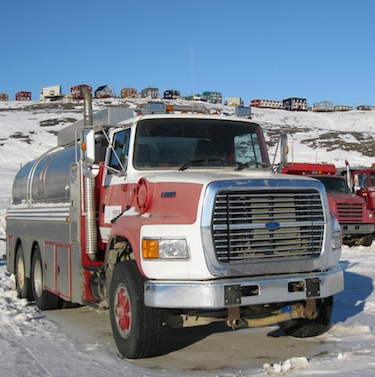Nunavut government set to inspect heavy commercial and municipal trucks
Checks will ensure 4.5-tonne vehicles are up to national standards

The Government of Nunavut’s Motor Vehicles Division is launching a heavy vehicle inspection program, starting with a first round of random inspections to commercial and municipal vehicles in Iqaluit next month. Yearly inspections will ensure the territory’s 4,500-kilogram vehicles, such as these in Iqaluit, are up to national safety standards. (PHOTO BY PETER VARGA)
Nunavut’s motor vehicles division will launch a heavy vehicle inspection program next month, starting in Iqaluit, aimed at ensuring all commercial and municipal vehicles weighing more than 4.5 tonnes are up to national standards.
“Our mandate is to ensure that we have safe vehicles on the road,” said James Demcheson, manager of motor vehicle safety and inspections for the Government of Nunavut. “This includes mechanically safe.”
The government will take its first steps in Iqaluit at the start of May, when Demcheson’s office will send out inspection notices to commercial businesses in Iqaluit.
These will notify businesses at random that specific 4,500-kilogram vehicles in the government’s database will be subject to inspection.
“Prior to us going on the site to do inspections on their vehicles, we’re educating them first about this, so that there’s no surprises, or that none of them would feel they’re being put on the spot, or picked on,” Demcheson told Nunatsiaq News.
Municipal vehicles will also be included in the random inspections.
Nunavut, like all other Canadian provinces and territories, is committed to following National Safety Code Standards, set by the Canadian Council of Motor Vehicle Transport Administrators.
This calls for annual inspections of trucks, tractors and trailers by government, or government-licensed agencies.
The Government of Nunavut has been well behind other jurisdictions in measuring up to the task. It is now taking its first steps to meet that goal.
Demcheson, who has headed up he safety and inspections division since 2010, noted that the territory’s lack of vehicle inspectors caught the attention of the Nunavut Chief Coroner’s office in 2005.
An inquest into the circumstances of four deaths, which involved heavy municipal vehicles in Iqaluit and Qikiqtarjuaq, included among its recommendations the need “to develop regulations and standards for safety and maintenance of commercial/municipal trucks and heavy equipment.”
The accidental deaths took place in 2000 and 2003. The first in 2000 involved a resident struck by a loader.
Others in 2003 involved residents accidentally struck by sewage pump trucks in Qikiqtarjuaq and Iqaluit, and a fourth Iqaluit resident struck by a backhoe in Iqaluit.
Other recommendations in the coroner’s report highlighted the need for more government-assigned vehicle inspection personnel, and better training of employees who operate heavy vehicles.
In 2005, “we only had one motor vehicle officer for the whole department,” Demcheson said.
“In the years after that, we started working on capacity-building. I’ve been working mainly on the tail end of that.”
Nunavut’s motor vehicles division now has three certified inspectors. Demcheson said he intends to add a fourth this year.
Starting next month in Iqaluit, the three inspectors will inspect a random selection of vehicles pulled from the motor vehicles division’s files.
The campaign will expand to other regions of the territory in June, Demcheson said, starting with Rankin Inlet and Cambridge Bay.
Budgets permitting this year, “hopefully we’ll be able to go to two or three other communities in each of the three regions of Nunavut,” he said.
The inspectors also work as driver examiners, he added, “so we may tie the inspections with their trips to the communities when they have to do driver examinations as well.”
Vehicles weighing 4,500 kg or more include large cube vans, tractor-trailer combinations, and passenger vehicles with a seating capacity of 10 or more.
School buses fall under a separate category, and will be subject to a different inspection program later this year.
Trucks that don’t comply to code will be barred from use “until defects have been corrected or repaired,” Demcheson said.
The standards also include criteria related to secure stowage of cargo, which the motor vehicles division eventually plans to verify in roadside inspections. Municipal enforcement officers will help with such inspections once they get underway.
For now, inspectors will focus on on-site inspections throughout the summer, Demcheson said.
Iqaluit has some 107 commercial vehicles, and another 30 or more municipal vehicles that weigh in at more than 4,500 kg. Demcheson’s department hopes to inspect as many as half of them by the end of the year, he said.
Nunavut’s Motor Vehicles Division registry shows that Nunavut has 344 commercial heavy vehicles, and at least 200 more municipal and territorial government vehicles in the same weight class.





(0) Comments